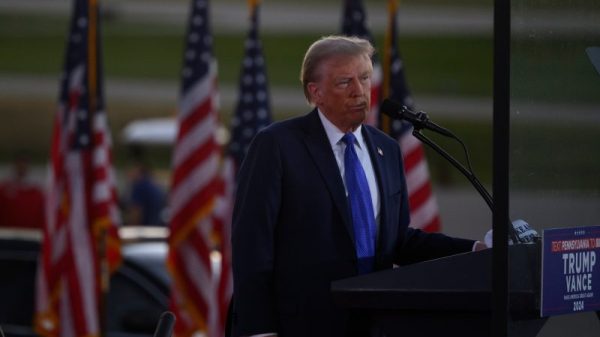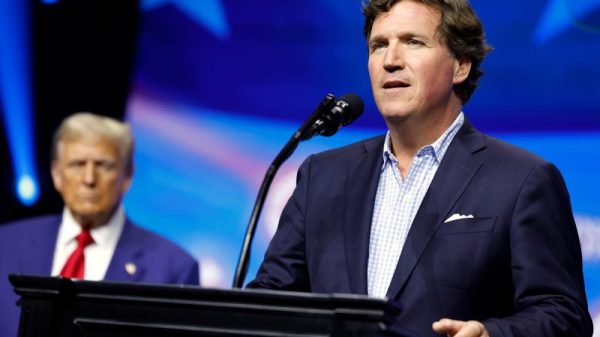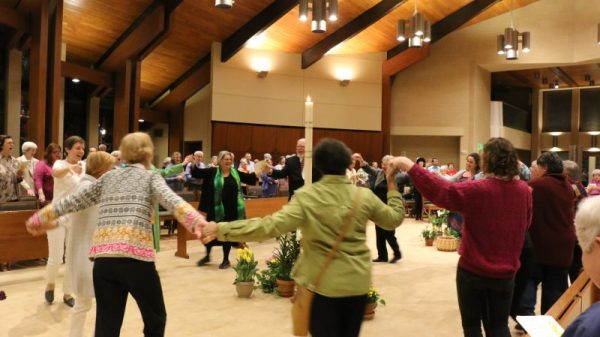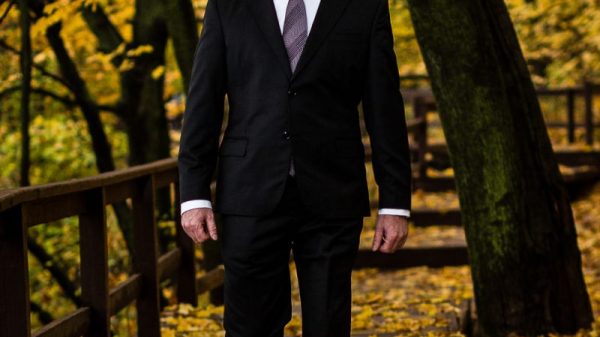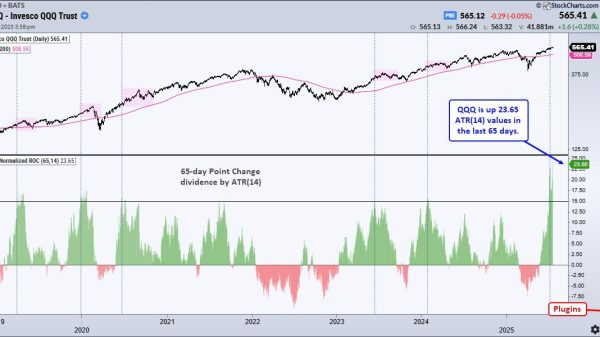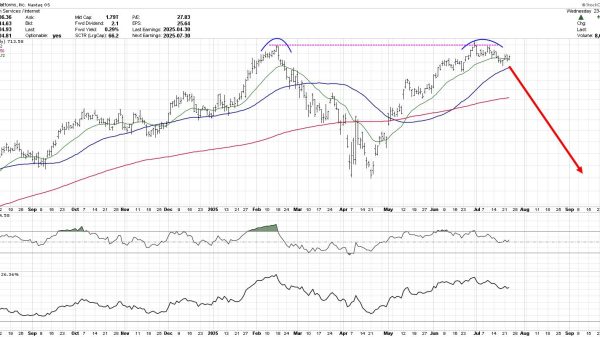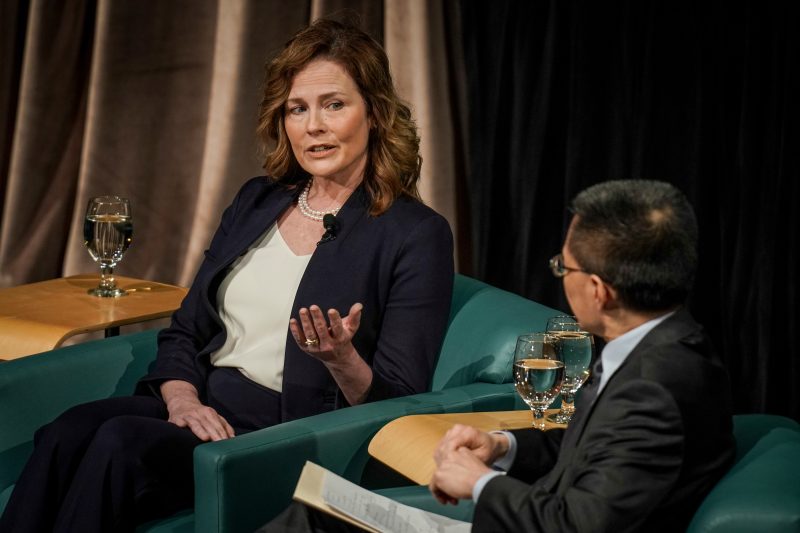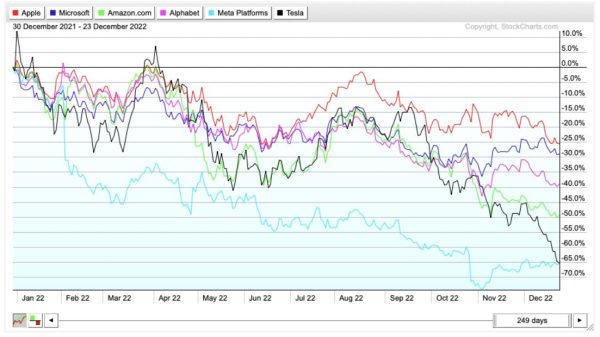The dissent was biting, accusing the Supreme Court’s conservative majority of “feeble” and “cherry-picked” arguments that inaccurately downplayed the Environmental Protection Agency’s role in protecting air quality.
Of course, all three liberal justices signed on.
But the writer was a conservative nominated by President Donald Trump: Justice Amy Coney Barrett, who charted a distinctive path during her breakout fourth term on the high court.
With piercing questions from the bench, and a willingness to break ranks with other Republican nominees in an era of conservative dominance on the court, Barrett played a new role this term — calling for a pragmatic, incremental approach to some cases in which her colleagues wanted to move more aggressively.
“She is an independent mind at work on a court that often falls into camps — and that’s refreshing to see,” said Deepak Gupta, a Washington lawyer who tracks the court’s work.
“The justice to watch,” said Melissa Murray, a New York University law professor and co-host of a liberal podcast about the court called Strict Scrutiny.
Barrett, a former law professor and federal appeals court judge, is still close to the right-leaning center of the court, and most often aligned with Chief Justice John G. Roberts Jr. and Justice Brett M. Kavanaugh. She spoke for them in a case involving emergency access to abortion care in Idaho, but broke from them with her dissent in the EPA lawsuit, which granted emergency relief to states and energy companies that challenged the Biden administration’s smog-reduction plan.
In another high-profile case, Roberts tapped her to write the decision rejecting a Republican-led effort to limit White House contacts with social media platforms about potential misinformation — a notable assignment for the second-most junior justice. Justices Clarence Thomas, Samuel A. Alito Jr. and Neil M. Gorsuch dissented.
Barrett, who at 52 is also the youngest justice, pushed back openly against other conservatives this term on the proper role of tradition and history in deciding cases. She did so most notably in her concurrence when the court upheld a federal gun law that takes guns from people who are subject to domestic violence restraining orders.
But legal analysts said her jurisprudence remains firmly to the right.
“Justice Barrett is everyone’s favorite conservative justice to talk about these days. But if anyone thinks she will ‘evolve’ over to the left side of the court, they are mistaken,” said Irv Gornstein, executive director of the Supreme Court Institute at Georgetown Law.
“She is a conservative jurist through and through. She is not going to be the next Harry Blackmun or David Souter,” he said in an email, referring to two past justices nominated by Republican presidents who became some of the court’s more liberal members.
Indeed, it was Trump’s September 2020 nomination of Barrett — a Catholic with antiabortion bona fides — that allowed the conservative majority to overturn Roe v. Wade two years later, eliminating the nationwide right to abortion after nearly 50 years.
Democrats were outraged that then-Senate Majority Leader Mitch McConnell (R-Ky.) pushed Barrett through to replace the late liberal icon Ruth Bader Ginsburg just days before the 2020 presidential election, instead of allowing the next White House occupant to make the pick. Stoking their anger was the fact that McConnell blocked President Barack Obama’s nomination of Merrick Garland several months before the 2016 contest.
Barrett has aligned with her fellow Trump nominees in most of the big cases that have ideologically divided the court, including decisions to end race-conscious college admissions and invalidate Biden’s student loan forgiveness program last term. This term, she voted with the other conservatives to curb the power of federal agencies that regulate major aspects of American life and extend broad immunity from prosecution to former presidents, including Trump.
But Barrett also split from her colleagues in part of Trump’s case, saying she agreed with the liberal justices that prosecutors should not have to exclude at trial any mention of a president’s immunized official acts in connection to the alleged wrongdoing.
“Justice Barrett is a conservative judge in multiple senses of the word. She certainly joins the court’s steps to the right in big cases,” Allison Larsen, who teaches at William & Mary Law School, said in an email. “But she also appears to prefer a conservative (lowercase c) methodology that is risk-averse, careful and deliberate.”
Her crossover votes and separate writing this term shows “she is far from the rigid conservative that some expected when she joined the court,” attorney Gregory S. Garre, who served as solicitor general under President George W. Bush, said in an email.
In previous years, Barrett subtly signaled her disagreements with other conservative justices, but still largely voted with them. This term, Harvard Law professor Richard Lazarus said, “she announced her split with both votes and all trumpets blaring.”
When the court said federal prosecutors overstepped in using an obstruction statute to charge defendants accused of disrupting the electoral vote count on Jan. 6, 2021, Barrett wrote the dissent. Joined by liberal Justices Sonia Sotomayor and Elena Kagan, she scolded the majority for suggesting that in passing the obstruction law, Congress did not intend it to apply to an event like the Capitol riot — or even envision such an event.
“Who could blame Congress for that failure of imagination?” she asked, parenthetically.
It is likely that Sotomayor, who has seniority among the liberal justices, assigned Barrett to write the dissent. The two appear to have a warm relationship and have headlined several joint public appearances to make the case for disagreeing more agreeably.
Barrett also diverged from the conservative majority when the court rejected a California lawyer’s effort to trademark “Trump Too Small” for use on T-shirts. Barrett agreed with the outcome but wrote separately to criticize the majority opinion — written by Thomas — saying some of its reasoning is “wrong twice over” and taking issue with Thomas’s “laser-like focus on the history.”
Jonathan Adler, a law professor at Case Western Reserve University who has known Barrett since her days teaching at Notre Dame, said Barrett is “speaking more directly and in her own voice.”
“More than some of the justices, if she’s going to support a change in the law, she really wants to know what’s on the other side of that door,” he said.
In one of the most closely watched cases of the term, Barrett showed she is increasingly comfortable criticizing any of her colleagues. When the court unanimously rejected a Colorado ruling that would have disqualified Trump from the ballot for his actions around Jan. 6, Barrett joined the liberals in a concurring opinion that said parts of the majority ruling went too far.
But Barrett suggested the liberals had overstepped as well in their separate opinion, which blasted their colleagues for trying to “insulate all alleged insurrectionists from future challenges to their holding office.”
Barrett said the case involving the presidential election called for comity. “For present purposes, our differences are far less important than our unanimity,” she wrote. “All nine Justices agree on the outcome of this case. That is the message Americans should take home.”
The justice has also distinguished herself with her questions from the bench. At oral argument in the emergency abortion case, Barrett expressed frustration with the attorney representing Idaho, whose responses appeared to differ from what was said in lower court proceedings.
“Counsel, I’m kind of shocked,” she said.
In a separate case challenging access to the abortion pill, Barrett, along with the other female justices, was extraordinarily specific in her questions. A mother of seven children, she talked openly about medical procedures after miscarriages and other aspects of reproductive health.
Last week, when the court cleared the way to at least temporarily allow access to emergency abortions in Idaho while litigation continues, Barrett — joined by Roberts and Kavanaugh — wrote that the shifting situation on the ground and evolving positions of the parties meant the court had mistakenly and prematurely intervened.
During the argument over Trump’s claims of immunity, Barrett seemed more interested in the practical implications of the court’s eventual ruling for the former president’s trial in D.C. than her fellow conservatives, who steered questions away from the alleged election interference and toward broader principles of executive power.
In a key exchange, Barrett got Trump’s lawyer to concede that many of the alleged acts in the special counsel’s indictment amount to private conduct that would not be shielded from prosecution.
Last fall, Barrett participated in an interview with Catholic University law professor Kevin Walsh, a fellow former law clerk to the late Justice Antonin Scalia. Barrett sounded a lot like a former law professor when she explained that she often writes separately to send a message to academics and lawyers about evolving legal questions or to provide direction to lower courts about the limits of an opinion.
“Anytime that I don’t join a part of an opinion,” she said, “I feel like I owe an explanation.”

